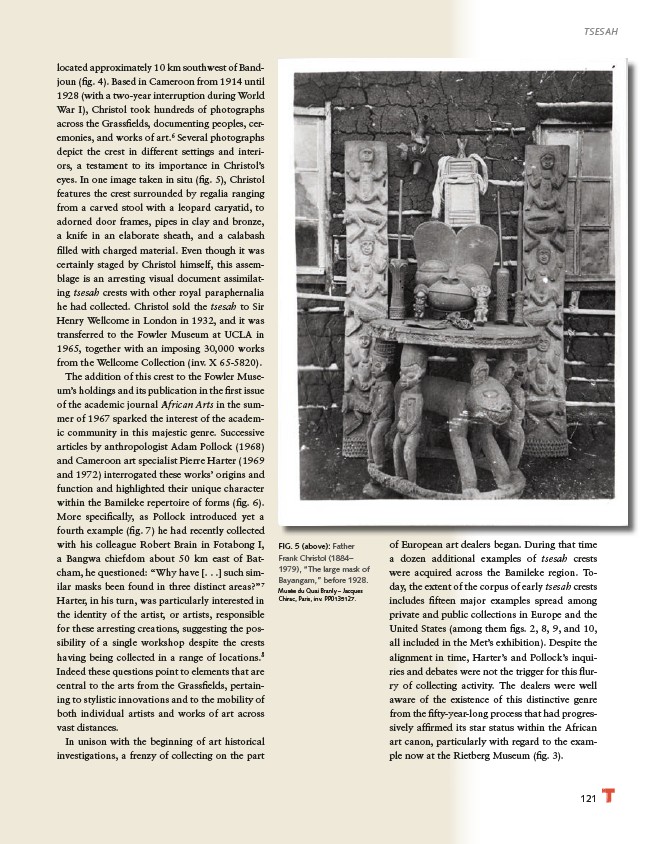
121
FIG. 5 (above): Father
Frank Christol (1884–
1979), “The large mask of
Bayangam,” before 1928.
Musée du Quai Branly – Jacques
Chirac, Paris, inv. PP0135127.
located approximately 10 km southwest of Bandjoun
(fi g. 4). Based in Cameroon from 1914 until
1928 (with a two-year interruption during World
War I), Christol took hundreds of photographs
across the Grassfi elds, documenting peoples, ceremonies,
and works of art.6 Several photographs
depict the crest in different settings and interiors,
a testament to its importance in Christol’s
eyes. In one image taken in situ (fi g. 5), Christol
features the crest surrounded by regalia ranging
from a carved stool with a leopard caryatid, to
adorned door frames, pipes in clay and bronze,
a knife in an elaborate sheath, and a calabash
fi lled with charged material. Even though it was
certainly staged by Christol himself, this assemblage
is an arresting visual document assimilating
tsesah crests with other royal paraphernalia
he had collected. Christol sold the tsesah to Sir
Henry Wellcome in London in 1932, and it was
transferred to the Fowler Museum at UCLA in
1965, together with an imposing 30,000 works
from the Wellcome Collection (inv. X 65-5820).
The addition of this crest to the Fowler Museum’s
holdings and its publication in the fi rst issue
of the academic journal African Arts in the summer
of 1967 sparked the interest of the academic
community in this majestic genre. Successive
articles by anthropologist Adam Pollock (1968)
and Cameroon art specialist Pierre Harter (1969
and 1972) interrogated these works’ origins and
function and highlighted their unique character
within the Bamileke repertoire of forms (fi g. 6).
More specifi cally, as Pollock introduced yet a
fourth example (fi g. 7) he had recently collected
with his colleague Robert Brain in Fotabong I,
a Bangwa chiefdom about 50 km east of Batcham,
he questioned: “Why have . . . such similar
masks been found in three distinct areas?”7
Harter, in his turn, was particularly interested in
the identity of the artist, or artists, responsible
for these arresting creations, suggesting the possibility
of a single workshop despite the crests
having being collected in a range of locations.8
Indeed these questions point to elements that are
central to the arts from the Grassfi elds, pertaining
to stylistic innovations and to the mobility of
both individual artists and works of art across
vast distances.
In unison with the beginning of art historical
investigations, a frenzy of collecting on the part
of European art dealers began. During that time
a dozen additional examples of tsesah crests
were acquired across the Bamileke region. Today,
the extent of the corpus of early tsesah crests
includes fi fteen major examples spread among
private and public collections in Europe and the
United States (among them fi gs. 2, 8, 9, and 10,
all included in the Met’s exhibition). Despite the
alignment in time, Harter’s and Pollock’s inquiries
and debates were not the trigger for this fl urry
of collecting activity. The dealers were well
aware of the existence of this distinctive genre
from the fi fty-year-long process that had progressively
affi rmed its star status within the African
art canon, particularly with regard to the example
now at the Rietberg Museum (fi g. 3).
TSESAH